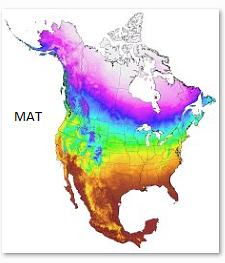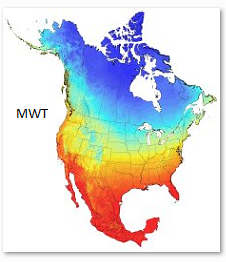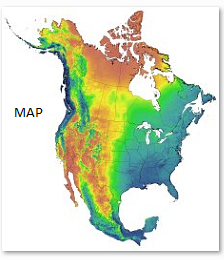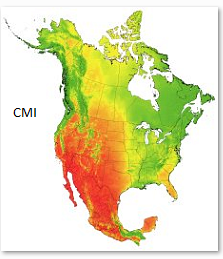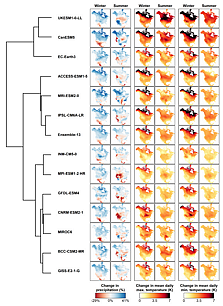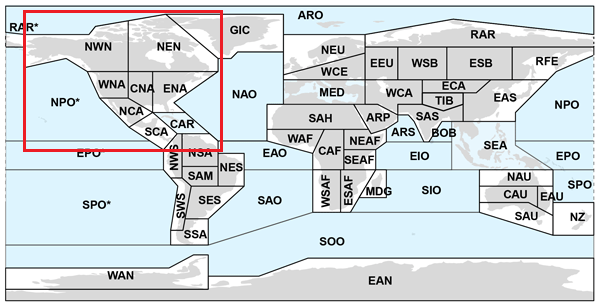On this page you can download the ClimateNA software and 1 km resolution climate grids, based on PRISM data. The software package can generate historical (1901-2024) and future (CMIP6) climate grids and point estimates for 25 bioclimatic, 16 monthly and 16 seasonal variables. (Note that we also now have an alternative package available, ClimateNA-ERA, that uses ERA5 data as the basis for downscaling).
The database includes monthly base variables (e.g., Tmin, Tmax, Tave & Prec) as well as economically or biologically relevant (bioclim) variables such as growing and chilling degree days, beginning and end of frost free preiod, heating and cooling degree days, Hargrave's climate moisture deficit and reference evaporation, and many more. The software can also provide scale-free point estimates of climate variables for user-provided latitude, longitude and elevation coordinates.
Gridded data at 1 km resolution are available from the tables on this page, but you may also explore some sample grids visually below: click on a thumbnails below and then zoom in or out of different areas ( ![]() ).
).
Downloads and References
The ClimateNA software does not require installation. Download, unzip, and double click the executable file ClimateNA.exe. The program should run on all versions of Windows. If you receive the error message "COMCTL32.OCX missing", you have to install these libraryfiles. The program also runs on Linux, Unix and Mac systems with the free software Wine or MacPorts/Wine).
ClimateNA v6.40 downloadable on this page is an older software version that corresponds exactly to the methods described in our 2016 paper (referenced below). It is well tested and internally used in my own lab for consistency with work done since 2016. However, the ClimateNA software is under active development, with new features, new historical data, and other improvements constantly being added. Get the latest version here: http://climatena.ca.
 Video tutorials on how to use the software to obtain climate data for sample locations, or to produce climate grids for a study area.
Video tutorials on how to use the software to obtain climate data for sample locations, or to produce climate grids for a study area.
Gridded data at 1km resolution
This dataset below was created by Carlos Carroll for AdaptWest, funded by the Wilburforce foundation. The gridded data were generated with the ClimateNA v7.30 software package. The download packages are zip files of either standard monthly variables (Tmin, Tmax, Tave, Prec) or derived bioclimatic variables (Bioclim) for historical and projected climate data. Unzip the downloaded packages to extract geoTIFF files compatible with most GIS applications in Lambert Azimuthal Equal Area projection. See the "Readme.txt" for further details and "Citation.txt" for how to cite usage of this database:
Readme file |
Elevation reference |
Citation |
|---|---|---|
| Readme.txt: |
geoTIFF: |
Citation.txt: |
based on a variety of quality criteria and representativeness. For details on GCM selection, see Mahoney et al. (2022).
2) Average projected global warming by the 2080s for different Shared Socioeconomic Pathways (SSP) scenarios:
SSP1-2.6: 1.5-2.0°C; SSP2-4.5: 2.5-3.0°C; SSP3-7.0: 3.5-4.0°C; SSP5-5.8: 4.0-5.0°C.
3) Projections for 30-year normal periods: 2020s: 2011-2040, 2050s: 2041-2070, 2080s: 2071-2100.
*) SSP2-2020s is a good choice to represent current climate (midpoint of "middle of the road" climate normal estimate).
Scenario selection to quantify uncertainty for different regions of North America
If you want to quantify uncertainty in future projections, you need to work with a selection of multiple, individual models. This is easily done with the provided software for locations of interest (see video tutorial), and in addition we provide gridded data for nine high quality and representative AOGCMs.
To help with the selection of a representative set of models for different regions of North America (or for the entire continent), we used the Katsavounidis-Kuo-Zhang (KKZ) algorithm, which selects an optimally representative set of future projections for different IPCC climate reference regions considering multiple climate variables (click on left panel dendrogram to visualize similarity among models):
A common approach is to select a median, a pessimistic and an optimistic projection, i.e., a subset size of 3. For example, to assess uncertainty of future projections in the Northwest North America region (NWN) with a 3-model ensemble, you would choose the models: CNRM (median), EC (optimistic), and ACC (pessimistic) from the table below (compare with the dendrogram above). More models (rows 4 to 8) will provide increasingly better represenation of uncertainty in future predictions in multivariate space.
To include the sensitive "outlier" model UKES in the model selection process, use the lower portion of the table. If UKES is included, this scenario will almost always be picked second, as the most "pessimistic" model of global warming. UKES is not a very likely outcome, but if you work with a larger ensemble, you may include it as one possible outcome. For details on the GCM selection process, see Mahoney et al. (2022).
Subset size |
IPCC climate reference region1 |
North America |
||||||
|---|---|---|---|---|---|---|---|---|
NEN1 |
NWN |
WNA |
CNA |
ENA |
NCA |
SCA |
||
| Excluding UKESM1-0-LL | ||||||||
| 1 | CNRM2 | CNRM | MRI | MRI | GISS | MRI | GISS | CNRM |
| 2 | EC | EC | MPI | GFDL | ACC | GFDL | ACC | GFDL |
| 3 | GFDL | ACC | GISS | MIR | MRI | EC | MIR | EC |
| 4 | MRI | MPI | MIR | CNRM | GFDL | MIR | EC | GISS |
| 5 | ACC | GISS | EC | GISS | CNRM | CNRM | GFDL | MIR |
| 6 | GISS | MIR | CNRM | EC | EC | MPI | MPI | ACC |
| 7 | MPI | MRI | GFDL | MPI | MIR | ACC | MRI | MRI |
| 8 | MIR | GFDL | ACC | ACC | MPI | GISS | CNRM | MPI |
| Including UKESM1-0-LL | ||||||||
| 1 | CNRM | CNRM | MRI | ACC | EC | MRI | GISS | CNRM |
| 2 | UKES | UKES | UKES | UKES | UKES | UKES | UKES | UKES |
| 3 | EC | EC | MPI | CNRM | GFDL | GFDL | ACC | GFDL |
| 4 | MPI | MPI | GISS | GFDL | MRI | EC | MIR | EC |
| 5 | MRI | ACC | EC | MIR | MIR | MIR | EC | MRI |
| 6 | ACC | GISS | CNRM | EC | GISS | CNRM | GFDL | GISS |
| 7 | GISS | MRI | MIR | GISS | MPI | MPI | MPI | MIR |
| 8 | GFDL | MIR | GFDL | MPI | ACC | ACC | CNRM | ACC |
| 9 | MIR | GFDL | ACC | MRI | CNRM | GISS | MRI | MPI |
ENA, E.North-America; NCA, N.Central-America; SCA, S.Central-America.
2) Model abbreviations are: ACC, ACCESS-ESM1-5; CNRM, CNRM-ESM2-1; EC, EC-Earth3; GFDL, GFDL-ESM4; GISS, GISS-E2-1-G; MIR, MIROC6;
MPI, MPI-ESM1-2-HR; MRI, MRI-ESM2-0; and UKES, UKESM1-0-LL.
Individual model downloads at 1km resolution
SSP1-2.6: 1.5-2.0°C; SSP2-4.5: 2.5-3.0°C; SSP3-7.0: 3.5-4.0°C; SSP5-5.8: 4.0-5.0°C.
2) Projections for 30-year normal periods: 2020s: 2011-2040, 2050s: 2041-2070, 2080s: 2071-2100.
References
Links to depreciated CMIP5 and CMIP3-based data sets
You can still access older, depreciated datasets that correspond to the 5th IPCC Assessment Report (2013) and are based on the CMIP5 multimodel dataset here. Similarly the dataset corresponding to the 4th IPCC Assessment Report (2009) can still be downloaded here.
